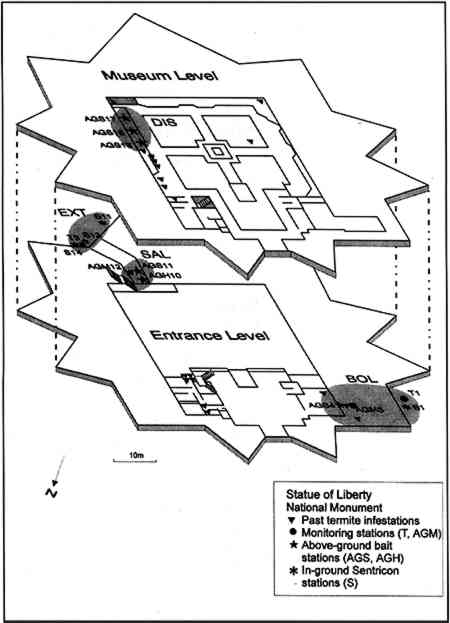ELIMINATION OF SUBTERRANEAN TERMITE POPULATIONS FROM THE STATUE OF LIBERTY NATIONAL MONUMENT USING A BAIT MATRIX CONTAINING AN INSECT GROWTH REGULATOR, HEXAFLUMURONNAN-YAO SU, JAMEY D. THOMAS, & RUDOLF H. SCHEFFRAHN
3 TERMITE INFESTATION IN THE STATUE OF LIBERTY NATIONAL MONUMENT3.1 LOCATING TERMITE INFESTATIONSAn inspection conducted in spring 1995 revealed numerous signs of termite activity throughout the two ground floors of the pedestal. Old foraging tubes (no live termites) were found on the concrete walls and floors of the preparatory rooms behind the reception desk at the north end of the pedestal on the entrance level (fig. 1, p. 285). Similar signs of past termite activity were also found along the wall-floor interface of the eastern side of the museum on the second floor, on the walls of the south corner, and inside a rest room. The widespread presence of termite foraging tubes confirmed our speculation that termites had been active for several years before 1994, and subterranean populations probably originated from the soil beneath and surrounding the pedestal.
Active foraging tubes and damaged wood containing live termites were also found in numerous locations in the two ground floors of the pedestal. To identify termite activity in soil, a stake survey (Su and Scheffrahn 1986) was conducted in 1995. Spruce stakes (Picea sp., 2.5 � 4.0 � 28 cm) were driven into the soil at 10 m intervals outside the exterior walls and were examined monthly to identify termite activity in soil. The survey revealed two termite activity loci: one in soil outside the boiler room and the other at the sally port (see fig. 1, T1 and T3). (The sally port was used as the visitor entrance to the statue in the late 1800s [Hugins 1956]). Based on survey results, we identified four clusters of termite activity: the boiler room (BOL), a display case in the second-floor museum area (DIS), the sally port (SAL), and the sally port exit (EXT). Termites flew in the boiler room and museum area in spring 1994, 1995, and 1996. 3.2 MONITORING TERMITE ACTIVITYTermite activity was monitored throughout 1995 by measuring wood consumption rate (mg wood consumed per day) from above- or in-ground monitoring stations; the number of active stations (both monitoring and bait stations with live termites); and termite feeding counts using an acoustic emission detector. Monitoring stations received untreated wood only, and baits containing hexaflumuron were applied in bait stations. 3.2.1 Above-Ground Monitoring Station (AGM)An above-ground monitoring station (Su et al. 1996) was attached directly over foraging tubes so that termites could access the wooden block through a precut hole on the plastic container. The station consisted of a plastic box (12 � 15.5 � 4.5 cm) containing a preweighed wooden block (Picea sp., 2 pieces, 9 � 3 � 2 cm and 8 � 5 � 2 cm, nailed together with a wooden handle, 8.5 � 3 � 2 cm). A thermal insulation layer made of closed-cell polyethylene foam (21.5 � 25 � 0.3 cm) was attached over the station using Velcro tape for easy detachment. 3.2.2 In-Ground Monitoring Station (T)In-ground monitoring stations were placed in the soil surrounding the monument walls where termite activity was detected by the stake survey. The stations consisted of Monitoring stations were checked monthly or bimonthly. Infested wooden blocks were washed to remove debris, dried at 80�C for 48 hours, and cooled in a desiccator before reweighing to determine the wood consumption rate (mg wood consumed per station per day). 3.2.3 Acoustic Emission DirectorAn acoustic emission detector similar to that described by Scheffrahn et al. (1993) was used to monitor termite activity in the wooden floors of the museum display area. The detector unit consisted of a main processor compartment (10 � 19 � 3 cm) connected by coaxial cables to two resonant acoustic emission sensors having integral amplifiers. The detector recorded sound waves of ultrasonic frequency (>20 kHz) that were generated when wooden fibers were broken by termite mandibles. Using the detector, termite-feeding episodes were recorded along longitudinally oriented wood grain up to 80 cm (Scheffrahn et al. 1993). |
